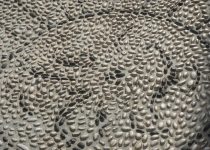How to Remove Brown Spots From Baseboards in Your Home
To remove brown spots from your baseboards, start by identifying the source, like mold or moisture issues. Clean with a solution of distilled white vinegar and water or use a baking soda paste for tougher stains. Wipe surfaces with a microfiber cloth. If stains persist, it might indicate deeper problems, such as leaks. Regular maintenance and prompt cleaning can prevent future stains. Keep going to discover more tips for effective stain removal and prevention.
Table of Contents
Key Takeaways
- Identify the source of brown spots, such as moisture, hair products, or tannin bleeding from the wood.
- Clean surfaces with a mixture of distilled white vinegar and water to remove stains.
- For tough stains, create a paste using baking soda and water, apply it, and then wipe off after sitting.
- If stains persist, consider sealing with a shellac-based primer before repainting for added protection.
- Regularly maintain caulking and use high-quality, stain-resistant paint to prevent future discoloration.
Understanding the Causes of Brown Spots on Baseboards
Brown spots on baseboards can be an eyesore in your home, and understanding their causes is the first step to tackling the problem.
One common culprit is staining from hair coloring products or moisture exposure. Tannin bleeding occurs when natural pigments in wood leach through low-quality paint, especially with cheap trim that doesn't accept paint well.
Poor sealing may also cause stains to resurface, particularly if the baseboards weren't primed properly.
Additionally, environmental factors like humidity can lead to water stains, intensifying the brown spots.
Essential Cleaning Supplies for Stain Removal
Removing those pesky brown spots requires the right cleaning supplies to get the job done effectively.
Start by gathering baking soda, distilled white vinegar, and warm soapy water. You can mix baking soda with water to create a paste that tackles stubborn stains without damaging your baseboards.
For a powerful cleaning solution, combine equal parts white vinegar and water in a spray bottle; this effectively targets stains and disinfects.
Use microfiber cloths to wipe down surfaces, as they trap dust and dirt while being gentle on your baseboards.
A toothbrush or cotton swabs are useful for getting into small crevices, ensuring you thoroughly clean every nook and cranny to keep your baseboards looking pristine.
Step-by-Step Guide to Removing Brown Spots
Dealing with brown spots on your baseboards can seem daunting, but following a simple step-by-step guide makes the process manageable.
Start by identifying the source of the stains, whether it's mold, tannin bleeding, or hair product overspray.
To remove the brown spots, mix distilled white vinegar with water and use a microfiber cloth to scrub the area gently, removing dirt and surface grime.
For tougher stains, create a paste with baking soda and water, apply it to the affected spots, and let it sit for a few minutes before wiping with a damp cloth.
Finally, seal any remaining stains with a B-I-N shellac-based primer to prevent bleed-through when repainting your baseboards.
Regularly inspect for moisture to maintain their appearance.
Persistent Stains: When to Consider Professional Help
While it's easy to overlook small stains, persistent spots on your baseboards can signal deeper problems that need professional attention.
If brown spots continue to appear despite your best efforts at stain removal, you might be facing moisture problems or mold issues. A professional assessment can reveal underlying causes like leaks or structural issues, which could lead to significant home damage if not addressed.
Experts can conduct mold testing to determine if these stains pose a health hazard due to mold spores. By consulting a professional, you ensure proper treatment and repair, preventing future recurrence and ensuring your home remains safe and damage-free.
Don't underestimate the importance of addressing persistent stains promptly!
Preventing Future Stains on Baseboards
Addressing persistent stains is important, but preventing future ones is even more critical for maintaining the appearance of your baseboards.
Here are some essential tips to keep them looking their best:
- Regularly maintain caulking around windows and doors to prevent moisture infiltration.
- Use high-quality, stain-resistant paint on your baseboards to repel contaminants.
- Ensure adequate ventilation in moisture-prone areas like bathrooms to combat mold growth.
- Promptly clean up any spills with appropriate cleaning solutions to avoid permanent stains.
Frequently Asked Questions
What Is the Brown Stuff on My Baseboards?
The brown stuff on your baseboards could be due to several factors. It might be hair dye overspray, moisture stains, or even mold growth. Identifying the specific cause will help you address it appropriately.
Is Magic Eraser Safe on Baseboards?
Yes, Magic Erasers are generally safe on baseboards, but use them gently. Always test a small area first to avoid potential damage or discoloration, especially on painted surfaces. Regular maintenance keeps your baseboards looking great!
What Causes Discoloration on Baseboards?
Discoloration on baseboards can occur from various factors. You might see stains from hair products, moisture-induced tannin bleed, or damage due to low-quality materials and environmental exposure. Water issues can also lead to mold growth.
How Do You Make Baseboards Look New?
To make your baseboards look new, clean them with warm soapy water, apply durable paint for lasting shine, touch up scratches, and regularly buff them with dryer sheets for a polished finish. You've got this!



